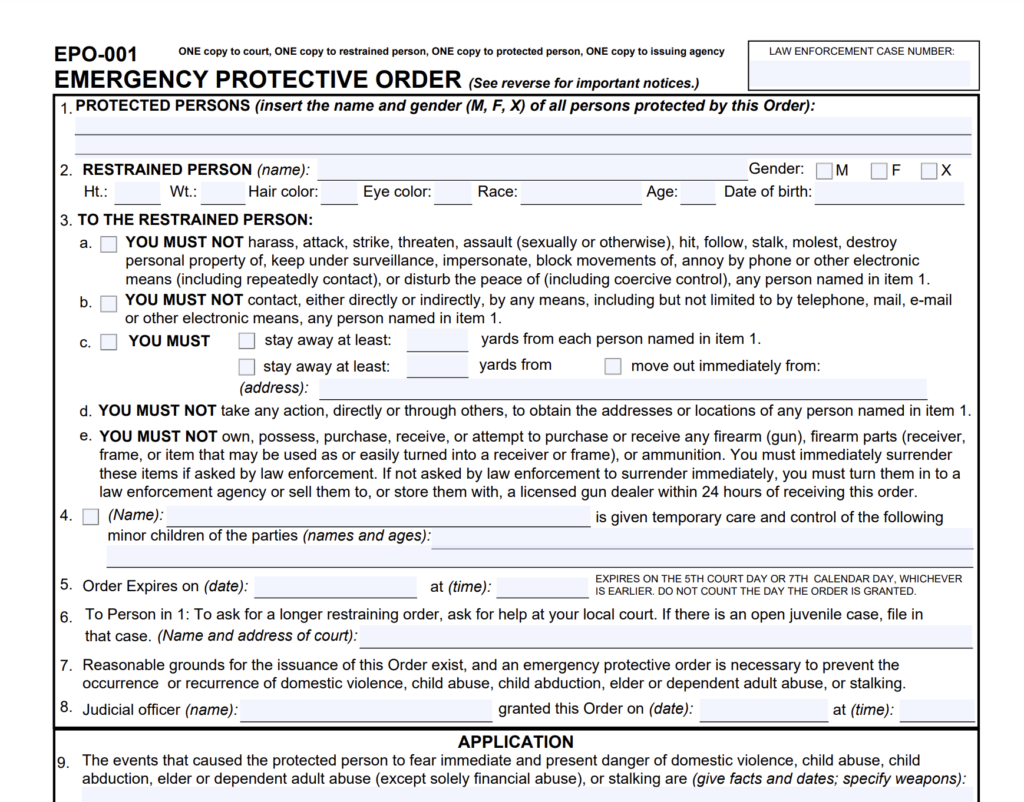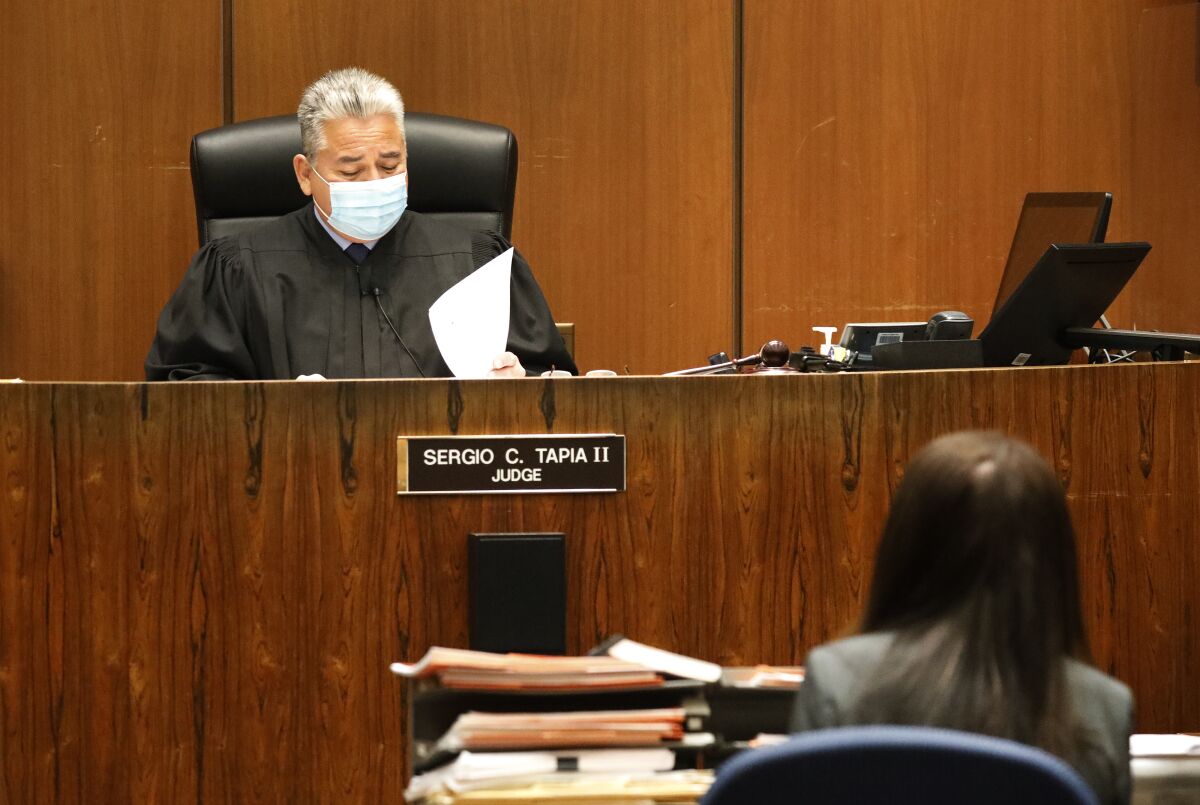How long does it take to get a restraining order in California
Recently updated on June 7th, 2025 at 03:23 pm
Getting a restraining order can take a variable amount of time depending on the danger to the safety of the victim. Here are common situations
- Police is called: In emergency situations in can be issued within 20 minutes 24×7 by the police who are called in such as via 9-1-1 call.
- When you file for a restraining order then a judge will review it and may issue a Temporary Restraining Order a temporary restraining order the same day (or within a day)
- In the rest of the cases, after about 3 weeks of filing there is a hearing held where the decision for an restraining order is made where the evidence from different parties will be examined.
Restraining Orders in California are court orders issued in situations such as abuse, stalking or harassment in range of ways from a current or former lover or relative, a neighbor, a co-worker or even a caregiver which require the abuser to stay a certain distance away from, and refrain from contacting the victim. Failure to comply with the restraining order can result in criminal charges and therefore these serve as effectively a final warning. In practice, these are relatively simple to get from your local court, highly effective for the victim, and additionally provide coverage against abusive and harassment acts which are emotionally painful but not technically a crime.
Domestic Violence Restraining Orders are free but Civil Harassment may have filing fee of about $435 depending the severity of the abuse.
Emergency Situation: Immediately
This is granted when 9-1-1 Emergency or a Police Station or Sheriff’s Office is contacted. All the paperwork is done by the law enforcement and there is no fee.

If there’s an emergency e.g. a husband hits his wife or there’s a high risk of harm a police officer or Sheriff can contact the judge remotely and issue what is called an Emergency Protective Order IMMEDIATELY within a few minutes. The idea is to provide a stop gap temporary order which is valid until the regular process for a temporary order can be pursued.
An EPO is issued by a judge at any time, day or night, and is usually valid for up to 7 days. This is typically used in domestic violence cases.
(Permanent) Restraining Order
The process for a Restraining Order starts when someone formally requests one by submitting a specific set of court forms at the local Superior Court either in person or online.
Optional Sub-step: Temporary Restraining Order
After a clerk accepts your case documents as complete, a judge privately reviews the documents offline in the backoffice. someone formally requests the court for a permanent restraining order during office hours, depending on the circumstances again the court may issue a Temporary Restraining Order (TRO) until a hearing is scheduled where the permanent version will be issued.
A TRO is granted to provide immediate protection until a court hearing can be held. It is typically valid until the hearing date, which is usually within 20-25 days.
(Permanent) Restraining Order
This is a continuation of the process started in the previous step titled “Temporary Restraining Order”. Once a court hearing is held the judge may either deny the whole order, or grants a permanent restraining order. If granted the restraining order can last up to 5 years, depending on the judge’s decision.
To initiate the process, you must file the appropriate forms with the court, and the timeline begins from the moment the paperwork is submitted. The speed of getting a restraining order largely depends on how quickly you can get to the courthouse and complete the necessary steps.
Steps: How do I file a restraining order
Step 1: Select the type of restraining order and gather evidence
There are a few different types of restraining orders and typically only one of them may apply to your situation so it’s important to select the correct one.

Domestic Violence
Select
Qualifying relationships
Someone you dated
Boyfriend / girlfriend
Husband / wife
Domestic partner
Partner’s ex-
Close relative
In-laws

Civil Harassment
Select
Qualifying relationships
Roommate
Neighbor
Co-worker / wife
Stranger
Landlord
Any other
Gather Evidence
The first step is to gather the evidence to support your case. What proof do you need for a restraining order in California. The following are examples to help you organize though anything that supports your claims can be used.

Criminal Case
A criminal case in progress shows that the district attorney also found evidence of the abuse or crimes and therefore supports your claims.

Photos
Photos of violence, injuries, damage
Messages
Print outs of messages, emails or transcripts of voicemail

911 Calls
For each call document the #, date, time, caller, callee details

Medical Records
Documentation of any medical emergencies or injuries or treatments resulting from abuser’s violence.

Police Report
Police reports filed against abuser for domestic violence.

Testimony
A testimony from a witness who can be a family member, neighbor a co-worker or a bystander, either in writing or in person at the hearing, describing the incidents witnessed.
Step 2: Get a copy of court forms
You can fill these online for free by visiting here
In order to apply for a restraining order, you need to fill and submit a specific set of official California court forms. These have questions aimed at understanding your situation and the people involved.
 Tip: Check your county’s Superior Court website Or use LegalAtoms to get a complete and updated list of required forms.
Tip: Check your county’s Superior Court website Or use LegalAtoms to get a complete and updated list of required forms.
Step 3: File with the County’s Superior Court
Filing is the process which means the following steps
- Formally submitting the case documents at the court with the office of the clerk
- The clerk reviews and verifies the correctness of forms and completeness of the required info
- Clerk enters the case in the court database, stamps the documents and assigns a case #
County (Venue)
The proper venue for a restraining order case is the county where the abuse took place or where the restrained party lives. However, venue is a defensive motion and should be considered by the court only if the restrained party objects by filing a noticed motion for change of venue at or before the time of responding to the request.25 Improper venue is not a proper basis for the court to deny relief on its own motion (sua sponte).
Determine the County
In California, one typically file at the Superior Court at county of your residence or where the abuse occurred. For example, if you live in San Francisco city, then the Superior Court of California, County of San Francisco. There can be many special cases and fine print but that is the most common case. Please consult a lawyer if your situation is uncommon e.g. the abuser is overseas or you are overseas and the abuser is in California.
Determine the Correct sub-location
Within the Superior Court of a county, there may be one location such as Superior Court of San Francisco OR multiple locations such as the one in San Bernardino, and each court has it’s own system so that you must file at the correct location.
For example here are some of the locations of the Superior Courts in California at San Bernardino County which are
- Barstow District: 235 East Mountain View Street Barstow, CA 92311
- Fontana District: Fontana District: 17780 Arrow Boulevard Fontana, CA 92335
- Joshua Tree District: 6527 White Feather Road Joshua Tree, CA 92252
- Needles District: 1111 Bailey Ave Needles, CA 92363
- Rancho Cucamonga District: 8303 Haven Avenue Rancho Cucamonga, CA 91730
- Victorville District: 14455 Civic Drive Victorville, CA 92392
- San Bernardino District: 351 North Arrowhead Avenue San Bernardino CA 92415
Identify the methods of Filing
Method # 1: In Person by visiting the court house
Your court location would accept the forms to be submitted in person at the court hours.
![]() Tip: All courts have lunch hours when they are closed for an hour
Tip: All courts have lunch hours when they are closed for an hour
When you submit your case documents at the court, typically you take 3 copies.
The clerks reviews it, and if everything is ok, they formally enter it into the court system and put a stamp near the top of the documents. That acceptance is called filing.
The stamp may look something like this:
Method # 2: E-file online
This is the most efficient option if you have an e-mail address and some basic computer skills like registering an account, and uploading PDF files.
Some counties now have one or more online portals where you create an account for free, and then you can upload documents and hit submit.
You will be required to some online service fees.
Method # 3: Via another person
Some counties accept filing via a friend or legal courier. These companies or individuals charge a flat or hourly fee and file the documents at the court.
Step 4: Judge Sets Hearing, Grant/Deny Temporary Restraining Order (TRO)
A judge reviews the case offline and then you will be notified by the court about the outcomes which are:
- Temporary Restraining Order Granted
- Temporary Restraining Order Denied
In addition the Judge would typically set a hearing. If the case doesn’t have sufficient evidence it might be dismissed without even a hearing.
The temporary order (if issued) is valid until the hearing i.e. typically about 3 weeks. If the hearing is delayed for any reason, you need to check with the court to ensure the temporary order is renewed until the hearing to provide you with legal protection.
Step 5: Serve a set of Stamped Case Forms including Hearing Notice to Abuser
Whenever one party initiates a restraining order it needs to inform or serve the other party formally by delivering the court documents. That step is called serving the respondent
Under the California law there are multiple ways in which the other party can be served.
![]() You cannot serve your papers yourself.
You cannot serve your papers yourself.
Option 1: Ask the Sheriff (FREE)
 A sheriff or marshal can serve the opposing party for you which is a big help. This service is offered for FREE. To ask the sheriff to serve your papers, you must have an address or location for the other side (restrained person). If the other side is in jail, the sheriff can serve them. If the other side is in prison in California, prison staff, not the sheriff, will serve your papers. Follow the instructions by the California Department of Corrections and Rehabilitation for serving someone in prison
A sheriff or marshal can serve the opposing party for you which is a big help. This service is offered for FREE. To ask the sheriff to serve your papers, you must have an address or location for the other side (restrained person). If the other side is in jail, the sheriff can serve them. If the other side is in prison in California, prison staff, not the sheriff, will serve your papers. Follow the instructions by the California Department of Corrections and Rehabilitation for serving someone in prison
Option 2: Ask a friend, relative or any adult (FREE)
 You ask someone you know to be your server
You ask someone you know to be your server
- 18 or over, and
- not part of your case
Think about safety when choosing your server. Get step-by-step instructions for how to have someone else, not the sheriff, serve your court papers.
Option 3: Hire a courier for legal papers (Process Server)
 You can also hire a courier called professional process server. You can search on Yelp or Google to get a list of options near you. Yelp Example . An example is ABC Legal Services.
You can also hire a courier called professional process server. You can search on Yelp or Google to get a list of options near you. Yelp Example . An example is ABC Legal Services.
You cannot hire regular couriers such as UPS, FedEx or US Postal Service unless in exceptional scenarios where the judge authorizes service by mail, but that’s a whole different topic altogether.
Step 6: Present Evidence in a Court Hearing
Attend a hearing: The court holds a hearing within a couple of weeks where the evidence is examined. If there is sufficient supporting evidence as determined by a Judge, a full restraining order is issued. At this point it becomes a crime for the abuser to break the conditions of the restraining order.

Step 7. Collect the Final Order
After the hearing, a final order may be issued. You can take a paper copy of the order with you. The order is typically valid for five years.
Related Posts
How do I update protections or restraints requested after filing for a restraining Order in California
If a temporary restraining order (TRO) has already been issued in California and you want to change or update the protections or restraints requested, here’s exactly what you can do: 🔁 How to Modify a Temporary Restraining Order (TRO) ✅ Option 1: Modify Before the Court Hearing You can request a change before the hearing…
DVPO Meaning – Domestic Violence Protection Order
Recently updated on June 7th, 2025 at 02:16 amIn Washington State, DVPO stands for Domestic Violence Protection Order which is a civil court order designed to protect someone from harm or threats by a family member, intimate partner, or household member. A DVPO in Washington can order the abuser to: Stay away from the victim’s…
How a Landlord can serve the notice to tenant in Florida
Recently updated on June 6th, 2025 at 11:30 pmIn Florida, serving a notice to a tenant depends on the type of notice and the situation. Here’s a breakdown of common types of notices and how to serve them: 1. Notice of Nonpayment of Rent (3-Day Notice) This notice is served when a tenant has failed…
What Are the Risks of Filing for Eviction in Florida?
Recently updated on June 6th, 2025 at 06:14 pmHere are the risks of filing for Eviction in Florida 1. Dismissal of the CaseIf the eviction paperwork has errors — like listing the wrong amount of rent, failing to properly serve the notice, or missing deadlines — the court could dismiss your case. That means you…


 Domestic Violence is for situations when the abuser is your current or former romantic partner or family member (not roommate)
Domestic Violence is for situations when the abuser is your current or former romantic partner or family member (not roommate) Civil harassment is for situations when the abuser is your roommate, neighbor, coworker, total stranger or anyone who is not a romantic partner or close family member.
Civil harassment is for situations when the abuser is your roommate, neighbor, coworker, total stranger or anyone who is not a romantic partner or close family member. Elder Abuse: is for situations when a senior citizen or disabled adult is being abused by a caretaker, neighbor or child .
Elder Abuse: is for situations when a senior citizen or disabled adult is being abused by a caretaker, neighbor or child . Gun Violence: is for cops or family members to apply for when an unstable person has a firearm, and risks hurting themselves or others. The court order requests firearms to be taken away.
Gun Violence: is for cops or family members to apply for when an unstable person has a firearm, and risks hurting themselves or others. The court order requests firearms to be taken away. Workplace Violence: An employer usually requests these to protect their employee(s) from a person who has stalked, harassed, been violent or threatened violence at the workplace.
Workplace Violence: An employer usually requests these to protect their employee(s) from a person who has stalked, harassed, been violent or threatened violence at the workplace. School Violence is for school officials to get when there’s risk of violence against students at a private college or university when the risk of violence is at the on campus.
School Violence is for school officials to get when there’s risk of violence against students at a private college or university when the risk of violence is at the on campus.








